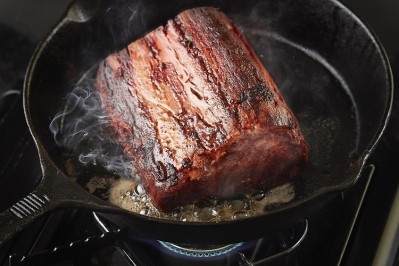Redefine Meat targets ‘meat-lovers’ with 3D printed plant-based solutions: ‘We’re closer than you think’

Plant-based products that attempt to mimic the organoleptic properties of their meaty counterparts have seen phenomenal growth in recent years, with Mordor Intelligence estimating that the market stood at $1.6bn in 2019 and is expected to grow by a CAGR of 12% through to 2026.
Interest is being propelled by a number of factors, from concerns about the environmental impact of intensive animal agriculture, to heightened concerns over animal welfare and the widespread belief that plant-based products are a healthier alternative.
While more people are identifying as vegetarian or vegan, a new generation of meat analogues has emerged to appeal to flexitarian consumers by delivering a ‘meaty’ experience. Products developed by the likes of Beyond Meat and Impossible Foods have made waves in the industry, extending the appeal of plant-based alternatives to a much broader audience.
Eshchar Ben-Shitrit, CEO and founder of Redefine Meat, acknowledges that the plant-based movement has its roots in the 1980s, when the likes of Quorn or Tivall began working on products that were ‘high protein’ and ‘tasty’ to cater to the vegetarian market. However, he credits Beyond Meat’s 2012 launch of a chicken-like substitute as catalysing the category.
“This kickstarted the movement to create a convincing meat substitute, in both taste and texture. Following close behind, Impossible Foods announced a burger in 2016 that took further steps in understanding the carnivorous consumer and recreate the composition of meat – importantly, they managed to accurately recreate the flavour profile of meat. For the first time in history, alt-meat started to feel really like actual meat,” he reflected.
But plant-based analogues have much further to go if they are to truly compete with the US$1.5trn meat industry – and drive the shift towards a truly sustainable protein future - Ben-Shitrit contends.
“Despite alt meat’s popularity reaching unprecedented heights in recent years, the industry is still some way off competing with the meat industry. Several decent alternatives to chicken and hamburger product exist, but step into any meat aisle in your average supermarket and get a real picture.”
Pointing to the ‘vast array’ of meats available – from beef and pork to chicken and lamb – as well as the various different cuts, product formats and recipes at a range of price points, Ben-Shitrit stressed the meat sector dwarfs current plant-based offerings.
“Even more importantly,” he continued, “many still do not consider even the best alt-meat products a good alternative to below average minced meat.”
Taking a bite out of meat sales
In order to appeal to the majority of meat-eaters, plant-based has to overcome significant psychological and social barriers, Ben-Shitrit noted.
“Asking for a drastic dietary shift is certainly not an easy ask, especially given that for many eating habits are ingrained in them since childhood. Meat isn’t just food; the act of eating meat for many is embedded in our culture, history, memories and passions. As a result, the goal of the alternative meat movement is making that transition for consumers as seamless as possible – bridging the gap between the accustomed taste, texture and experience of meat and the current experience when consuming plant-based meat.”
In some ways, this is easier said than done.
Ben-Shitrit continued: “The key to unlocking the true potential of alt-meat is understanding the composition of meat – not just from a biological standpoint, but why and what exactly it is that people love about it. Replicating the taste and appearance is not enough. Alt meat products that will convert your longstanding meat lover need to create the ‘complete experience’ comprising taste, texture, visual appearance, cooking behaviour and smell to name a few.
“No-one is aware of the thousands of processes taking place when we bite through a juicy piece of meat – but our brain does. At the end of the day, for mass conversion to take place consumers need to easily incorporate alt-meat products in their lifestyle and habits as opposed to just enjoying the taste as a one-off novelty.”
Ben-Shitrit suggests that to truly tap this market, plant-based innovators need to ‘work alongside the existing meat industry, instead of against them’. “After all, who knows more about meat than the ones who work with it on a daily basis…. It’s essential that all their expertise is fed into the alt meat development process in order to create better products.”
The need for technological and process innovation
What will these ‘better products’ of the future, that can extend the appeal of alt meats beyond their current niche, look like?
“Tackling the challenge at a production process level is essential to drive meaningful change,” Ben-Shitrit argued. “Today, many food companies approach development at the product or ingredient level, altering recipes to bring out newly enhanced products such as the next yogurt or chocolate bar. But if 100 companies each work on one product, even if they are all successful, you will ultimately only have 100 products. On the flipside, if you have ten companies working on new technologies or processes that can generate entirely new products, you can create thousands of products.
“If we apply this to the alt meat industry, today most companies are developing better burgers or improved chicken nuggets at the product-level. However, if we want to seriously change the make-up of the traditional supermarket meat aisle… then new technologies and production processes need to emerge to match what conventional meat already offers.”
And this is just what Redefine Meat is working towards, with a focus on making production ‘as efficient and adaptable’ as possible.
“To significantly enhance the tasting experience of alt-meat for consumers, leveraging innovative technologies to create new production processes is essential to overcoming the limitations of current alt-meat production techniques,” Ben-Shitrit insisted.
Redefine Meat has developed a 3D printing process that, the food innovator claims, enables the ‘precise composition of meat layer by layer to bring every fibre of real meat to fruition in a way that conventional alt meat processes cannot’.
“This production method opens up a vast array of possibilities, offering new players across the food supply chain the ability to accurately control the characteristics of meat they require, such as the specific marbling of Wagyu beef from Japan or the texture of grass-fed Australian Angus prime beef. The emergence of new technologies capable of creating an alt-meat tasting experience that resembles the animal meat we are accustomed to, will be vital to converting mass meat lovers to plant-based alternatives.”
3D printing for better, faster innovation and food security
The adoption of digital production methods, such as 3D printing, also allows for advanced AI & machine learning technologies to further optimize the alt-meat experience for consumers, Ben-Shitrit continued. This can be leveraged to inform and accelerate further innovation.
“With the ability to learn consumer habits, likes, dislikes and more, these learnings can be fed through into development to ensure the meat production matches consumer requirements. This can drive a more modern ‘digitalized’ supply chain built to adopt innovation at a faster pace, delivering new alt-meat products faster based on consumer needs – so much so that you can customize meat offerings to suit varying tastes and dishes,” he predicted.
3D printing can also be used to shorten supply chains and bring production to a local level, ‘completely reinventing the traditional supply chain and its centralised production models’, according to the Redefine Meat founder.
“Instead of depending on suppliers to deliver meat from across the globe, 3D printing opens up a world of on-demand production at the site you need it, when you need it, in the exact quantity you need. Not only does this further increase sustainability in production by hugely reducing the pollution associated with logistics and waste, 3D printing meat can also play a major role in overcoming meat shortages derived from disrupted supply chains.”
This can help build supply chain resilience. “You only have to look at what we’re facing right now with COVID-19, where meat production plants have suffered outbreaks and cross-border logistics severely disrupted. Or in recent times, geo-political issues such as Brexit or the US-China trade war that can directly impact the supply chain. With on-demand production enabled directly at the site that needs product, these supply chain bottlenecks can be overcome.”
A 3D printed future ‘closer than you think’
This might sound like some kind of sci-fi future – but Ben-Shitrit says ‘the reality is that we’re closer than you think’.
“Companies such as ours are making rapid developments at the production-process level to create meat from plant-based proteins that more closely align to the meat experience most of us have been accustomed since childhood. Through closer collaboration with the traditional meat industry to better understand ‘what makes meat, meat’, these new production methods are being enhanced even further – which will be vital to evolving the alt meat industry to the next phase.
“For consumers, they can enjoy more options regarding the source of meat they consume – animal-based, plant-based, fungi-based and, in the future, cultured meat. This allows conscious carnivores to actively make a change to reduce their food environmental impact – just like with their transportation habits.”
Currently, plant-based meat analogues command something of a price premium. The sector does not operate at a scale needed to optimise supply chains and, as in all cutting edge areas, innovators in the space face significant R&D expenditures. But Ben-Shitrit believes this, too, will change. “More affordable protein sources will become a viable option, allowing the alt- meat industry economies of scale it lacks today. We will have less hormones, cholesterol and animal-related pathogens in our food system, which will have an overwhelmingly positive impact on our lives.”





















